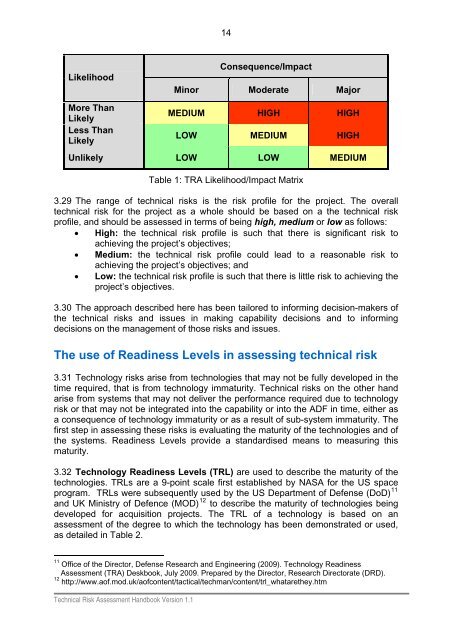Technical Risk Assessment Handbook - Defence Science and ...
Technical Risk Assessment Handbook - Defence Science and ...
Technical Risk Assessment Handbook - Defence Science and ...
Create successful ePaper yourself
Turn your PDF publications into a flip-book with our unique Google optimized e-Paper software.
14<br />
Likelihood<br />
Consequence/Impact<br />
Minor Moderate Major<br />
More Than<br />
Likely<br />
Less Than<br />
Likely<br />
MEDIUM HIGH HIGH<br />
LOW MEDIUM HIGH<br />
Unlikely LOW LOW MEDIUM<br />
Table 1: TRA Likelihood/Impact Matrix<br />
3.29 The range of technical risks is the risk profile for the project. The overall<br />
technical risk for the project as a whole should be based on a the technical risk<br />
profile, <strong>and</strong> should be assessed in terms of being high, medium or low as follows:<br />
• High: the technical risk profile is such that there is significant risk to<br />
achieving the project’s objectives;<br />
• Medium: the technical risk profile could lead to a reasonable risk to<br />
achieving the project’s objectives; <strong>and</strong><br />
• Low: the technical risk profile is such that there is little risk to achieving the<br />
project’s objectives.<br />
3.30 The approach described here has been tailored to informing decision-makers of<br />
the technical risks <strong>and</strong> issues in making capability decisions <strong>and</strong> to informing<br />
decisions on the management of those risks <strong>and</strong> issues.<br />
The use of Readiness Levels in assessing technical risk<br />
3.31 Technology risks arise from technologies that may not be fully developed in the<br />
time required, that is from technology immaturity. <strong>Technical</strong> risks on the other h<strong>and</strong><br />
arise from systems that may not deliver the performance required due to technology<br />
risk or that may not be integrated into the capability or into the ADF in time, either as<br />
a consequence of technology immaturity or as a result of sub-system immaturity. The<br />
first step in assessing these risks is evaluating the maturity of the technologies <strong>and</strong> of<br />
the systems. Readiness Levels provide a st<strong>and</strong>ardised means to measuring this<br />
maturity.<br />
3.32 Technology Readiness Levels (TRL) are used to describe the maturity of the<br />
technologies. TRLs are a 9-point scale first established by NASA for the US space<br />
program. TRLs were subsequently used by the US Department of Defense (DoD) 11<br />
<strong>and</strong> UK Ministry of <strong>Defence</strong> (MOD) 12 to describe the maturity of technologies being<br />
developed for acquisition projects. The TRL of a technology is based on an<br />
assessment of the degree to which the technology has been demonstrated or used,<br />
as detailed in Table 2.<br />
11 Office of the Director, Defense Research <strong>and</strong> Engineering (2009). Technology Readiness<br />
<strong>Assessment</strong> (TRA) Deskbook, July 2009. Prepared by the Director, Research Directorate (DRD).<br />
12 http://www.aof.mod.uk/aofcontent/tactical/techman/content/trl_whatarethey.htm<br />
<strong>Technical</strong> <strong>Risk</strong> <strong>Assessment</strong> <strong>H<strong>and</strong>book</strong> Version 1.1

















